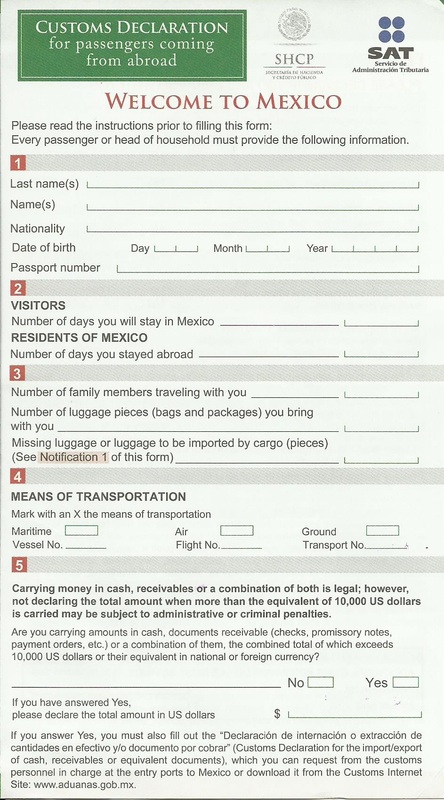

- #CUSTOMS FORMS TO GO TO MEXICO FROM USA FULL#
- #CUSTOMS FORMS TO GO TO MEXICO FROM USA SOFTWARE#
Customs Forms: When you send merchandise (anything that's not correspondence or documents), it must have a customs form that's computer-generated (not handwritten) by approved USPS software that electronically sends the customs form data to U.S. Things You Can't Send: There are more things you can't send in international packages, and each country has its own rules about what it'll allow in inbound packages. Rules: There are more rules, laws, and regulations that you must follow (from USPS, the U.S., and the destination country), and you are responsible for following all of them. Tracking: Depending on how and where you ship, you may not get the same level of tracking information you're used to for U.S. Passengers that arrive by air will be required to put their bags through an X-ray machine, and then move to the kiosk and push a button to determine whether their luggage will be selected for any further inspection.Sending packages to other countries is different from sending packages inside the U.S.: If you have an unusual amount of luggage or an oversized piece, you may be subject to inspection. Travelers can also contact the Mexican Embassy or closest Mexican Consulate for more current information. The child must be carrying the original letter (not a facsimile or scanned copy), and proof of the parent/child relationship (usually a birth certificate or court document) and an original custody decree, if applicable. Department of State recommends that permission include travel dates, destinations, airlines, and a summary of the circumstances surrounding the travel. This permission must include the name of the parent, the name of the child, the name of anyone traveling with the child, and the notarized signature(s) of the absent parent(s). Note on travel of minors: Mexican law requires that any non-Mexican citizen under the age of 18 departing Mexico without both parents must carry notarized written permission from the parent or guardian who is not traveling with the child to or from Mexico. If you plan to enter Mexico by car, please read the vehicle's importation requirements. Travelers who fail to have their tourist card stamped may be fined, detained, or expelled from the country. If you do not receive a stamped tourist card at the border, ensure that, when you arrive at your destination within Mexico, you immediately go to the closest National Institute of Immigration office, present your bus ticket, and request a tourist card. If traveling by bus or car, ensure that you obtain such a card at the immigration module located at the border and have it stamped by immigration authorities at the border. The fee to replace the FMM is about $30 USD. Taking a photo of the document is a good idea. 
If you do lose it, you'll need to apply for a replacement at a local immigration office (available in every city and many towns) or at the airport. Try not to lose it, as you'll need to show it when leaving the country, to prove you are within the 180 day limit. At the entry point, you'll be given a Mexico Visitor's Permit (FMM) to fill out. Visitors can stay legally for up to 180 days.
No visa is required for visitors to Mexico from Australia, Canada, New Zealand, the U.K., and the U.S., among other countries (see for the full list). If you lose your passport, visit the nearest consulate of your native country as soon as possible for a replacement. Safeguard your passport in an inconspicuous, inaccessible place, and photograph the critical pages (those with your passport number and photo) so you have a digital record of it. and Canada, Mexico, the Caribbean region, and Bermuda, whereas a regular passport will work around the world.


citizens may apply for the limited-use, wallet-size Passport Card, but we think applying for a regular passport makes more sense, as the passport card is valid only for land and sea travel between the U.S. Armed Forces on active duty are eligible for fee-free passports. Other valid travel documents include the Passport Card and the U.S. and Canadian citizens, attempting to enter the United States by land or sea must have a valid passport or other WHTI compliant document. In addition, all travelers, including U.S. and Canadian citizens traveling by air or sea to Mexico are required to present a valid passport or other valid travel document to enter or reenter the United States except if returning from a closed-loop cruise.








 0 kommentar(er)
0 kommentar(er)
